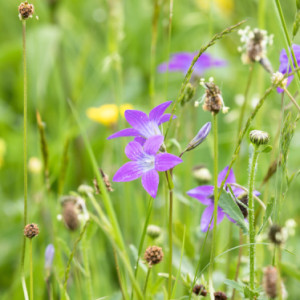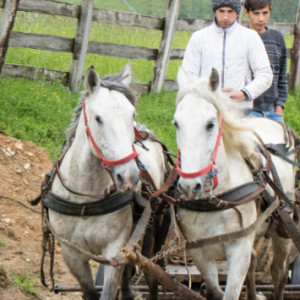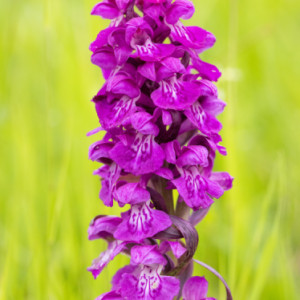Zărneşti Gorge and Măgura
We awoke to a drizzly morning, however this did nothing to curb the activity of busy House Martins, Swallows, Common and Black Redstarts, with hungry and demanding mouths to feed. The calls of a Cuckoo reverberated around the valley as Fieldfares did their best to hide in trees and bushes.
We took the short drive down the mountain from Măgura to meet Dan who was waiting to meet us for an exploration of Zărneşti Gorge. The rain this morning must be described as determined, but so were we as we set off along the gorge to look for plants. Dusky Crane's-bill Geranium phaeum was common, along with Large Red Dead-nettle Lamium garganicum , Yellow Archangel Lamium galeobdolon , Wood Stitchwort Stellaria nemorum and Water Avens Geum rivale .
We spotted a Fire Salamander as it clambered around a pile of rocks, and the ensuing photo call allowed the Agile Frog also using the area to beat a hasty retreat. Cheerful splashes of yellow were occasionally offered by Carpathian Leopard's-bane Doronicum carpaticum . Red Lungwort Pulmonaria rubra and Tuberous Comfrey Symphytum tuberosum were occasionally spotted, along with Alpine Clematis Clematis alpina adorned with beautiful blue flowers, and Yellow Wood Violet Viola biflora . Among rocky patches we found patches of Alpine Bells Primula matthioli .
The cool and damp day did nothing to encourage butterflies into the skies, however we did spot a couple of their tougher cousins, with the moths Speckled Yellow, Barred Hook-tip and Dark Brocade being found, along with several impressively large Roman Snails, and a colourful Golden Ground Beetle.
On the rocks we found a trio of spleenworts: Asplenium cuneifolium , Maidenhair Spleenwort Asplenium trichomanes and the similar Green Spleenwort Asplenium viride , given away by its green stipes and rachides. Spoon-leaved Saxifrage Saxifraga cuneifolia, Wedgeleaf Saxifrage Saxifraga adscendens and the small figwort Scrophularia heterophylla made their homes in among the crevices.
High up on the towering limestone walls we found a small party of five Balkan Chamois, effortlessly moving along the sparsely vegetated upper reaches of the gorge. The gorge had one final treat in store for us, as we found a pair of Wallcreepers; flashes of black, white and red as they tended to a nest high up in the gorge.
After lunch while some of the group headed to nearby Bran Castle, the remainder took some time to explore the meadows and verges of Măgura. Under increasingly darkening skies we found a good range of species, many of which would become familiar sights, such as Hoary Plantain Plantago media , Spreading Bellflower Campanula patula , Arrow-jointed Broom Genista sagittalis and Common Milkwort Polygala vulgaris. These were joined by the small nodding heads of Blue Fleabane Erigeron acris , Fox-and-cubs Pilosella aurantiaca, Wild Liquorice Astragalus glycyphyllos , Eastern Goat's-beard Tragopogon orientalis and Cream Scabious Scabiosa ochroleuca. The striking Carthusian Pink Dianthus carthusianorum was starting to flower in the meadows, alongside the equally colourful Sticky Catchfly Viscaria vulgaris and the less showy Nottingham Catchfly Silene nutans .
Large Yellow Foxglove Digitalis grandiflora was just beginning to flower while only the leaves of the autumn-flowering Meadow Saffron Colchicum autumnale were visible. Green-winged Orchids Anacamptis morio were spotted along with a patch of Western Marsh Orchid Dactylorhiza majalis, and the first Marsh Fragrant Orchids Gymnadenia conopsea were starting to flower high up on a slope where Globeflower Trollius europaeus also grew. The sound of thunder echoing around the valley along with the persistent rain finally encouraged us it was time to head back to our accommodation.
Extract from Wildlife Travel Transylvania trip report, Laurie Jackson, June 2019




Comments
Sign in or get an account to comment.


